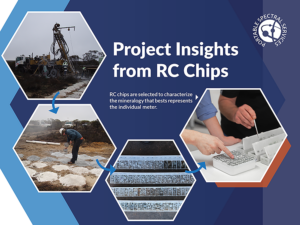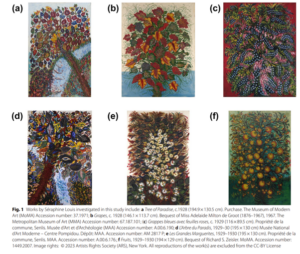
Automated Capture of AC/RC Chip mineralogy
Automated micro-X-ray fluorescence (micro XRF) technology emerges as a powerful tool to rapidly and accurately capture the mineralogy of rock chip, RC and AC samples.
Pumpkin seeds, often referred to as “pepitas,” are more than just a crunchy snack. They are a nutritional powerhouse, packed with protein, healthy fats, fiber, vitamins, and minerals. In recent decades, numerous researchers have explored different species within the Cucurbita genus. They have discovered that certain species possess a range of potential medicinal benefits, from heart health to immune support. However, the quality and composition of pumpkin seeds can vary greatly. Factors that influence this can be variety, growing conditions, and processing methods. Minerals play a significant role both in nature and within the human body. This study aims to delve into the elemental compositions of various seed species, utilizing the Bruker M4 TORNADO PLUS as a tool to unravel the intricate mineral characteristics of these diverse seeds.
Six different varieties of pumpkin seeds underwent a meticulous scanning process using micro-XRF. This comprehensive analysis covered not only the outer shell but also the cross-sectional properties of the seeds. The scanning parameters employed were set at 45kV, 600μA, 30ms, and a resolution of 40 μM. To ensure the accuracy of the results, the samples were scanned within a controlled vacuum environment of 2mbar. Following the scanning process, the samples were subjected to further processing to create detailed elemental maps.
Mineral Composition
Micro XRF is a powerful tool for delving into the mineral composition of pumpkin seeds, allowing us to uncover their nutritional value. Magnesium, for example, plays a crucial role in muscle and nerve function, while zinc is essential for a healthy immune system. Iron, another vital mineral, aids in oxygen transport within the body. By using Micro XRF, researchers can precisely quantify the concentration of these minerals, providing a comprehensive understanding of the nutritional benefits offered by different pumpkin seed varieties.
Contaminant Detection
In the journey from the pumpkin patch to our plates, pumpkin seeds may encounter potential contaminants during processing or storage. Micro XRF serves as a vigilant guardian in this regard. It possesses the remarkable capability to detect harmful elements such as lead or cadmium, which can jeopardize the safety of these delectable snacks. Through this non-destructive technique, the food industry can guarantee that the pumpkin seeds we consume are free from detrimental substances, ensuring the well-being of consumers.
Varietal Differences
Australia is home to a diverse range of pumpkin varieties, each with its unique characteristics. By employing Micro XRF analysis, they can discern the mineral disparities between different pumpkin varieties. For instance, they can identify which varieties are more abundant in specific minerals. This knowledge not only informs consumers about the nutritional distinctions but also empowers producers to make informed decisions about cultivation and production, further promoting the rich diversity of Australian pumpkins.
Quality Control
Food producers face the crucial task of ensuring that their pumpkin seed products meet specific nutritional standards and quality expectations. Here’s where Micro XRF plays a pivotal role. By integrating Micro XRF into their quality control processes, producers can maintain stringent standards. This advanced analytical technique allows them to precisely assess the mineral content and quality of pumpkin seeds, ensuring that the final products align with the desired nutritional benchmarks. It’s a proactive approach to consistently deliver high-quality pumpkin seeds to consumers, reinforcing trust in Australian-grown produce.
Whole Seed Scans
In the comprehensive analysis of whole pumpkin seeds, the study uncovered the elemental composition of Iron (Fe), Magnesium (Mg), and Potassium (K). These minerals play pivotal roles in human nutrition. Iron is essential for oxygen transport within the body, while Magnesium supports muscle and nerve function. Potassium is crucial for maintaining proper heart function and fluid balance. By analyzing these minerals in whole seeds, the research offers valuable insights into the nutritional content of pumpkin seeds, enabling consumers to make informed dietary choices.
Cross-Section Scans
For a more in-depth exploration, the study extended its analysis to the cross-sections of the pumpkin seeds, encompassing a broader spectrum of minerals, including Calcium (Ca), Iron (Fe), Phosphorus (P), Magnesium (Mg), and Potassium (K). Calcium is indispensable for strong bones and teeth, while Phosphorus plays a crucial role in energy metabolism. These cross-section scans reveal the intricate mineral complexities within the seeds, shedding light on their potential as a well-rounded source of nutrition. The findings underscore the multifaceted benefits of pumpkin seeds and serve as a valuable resource for both researchers and consumers seeking to harness the nutritional richness of these Aussie-grown seeds.
In conclusion, the analysis of whole seeds and cross-sections provides a holistic understanding of the mineral content within pumpkin seeds. It highlights the nutritional significance of these seeds, making them an attractive and wholesome addition to diets. Moreover, this research supports the broader appreciation of the diverse and beneficial contributions that pumpkin seeds make to the culinary and health landscape in Australia.

Automated micro-X-ray fluorescence (micro XRF) technology emerges as a powerful tool to rapidly and accurately capture the mineralogy of rock chip, RC and AC samples.

Findings of an ongoing regional evaluation study over concealed Proterozoic lithologies known to host magmatic nickel sulphides with potential to host other base-metal, gold and rare earth elements (“REE”) systems within the Fraser Range, Western Australia.

Findings of an ongoing regional evaluation study over concealed Proterozoic lithologies known to host magmatic nickel sulphides with potential to host other base-metal, gold and rare earth elements (“REE”) systems within the Fraser Range, Western Australia.

Findings of an ongoing regional evaluation study over concealed Proterozoic lithologies known to host magmatic nickel sulphides with potential to host other base-metal, gold and rare earth elements (“REE”) systems within the Fraser Range, Western Australia.

Findings of an ongoing regional evaluation study over concealed Proterozoic lithologies known to host magmatic nickel sulphides with potential to host other base-metal, gold and rare earth elements (“REE”) systems within the Fraser Range, Western Australia.

Findings of an ongoing regional evaluation study over concealed Proterozoic lithologies known to host magmatic nickel sulphides with potential to host other base-metal, gold and rare earth elements (“REE”) systems within the Fraser Range, Western Australia.
